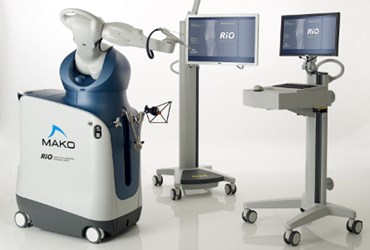Demand For Minimally Invasive Surgery Driving Surgical Robotics Development, Miniaturization
By Jof Enriquez,
Follow me on Twitter @jofenriq

The growing adoption of minimally invasive surgery is driving surgical robotics development and increased miniaturization of surgery instrumentation. Several upcoming surgical robotic technologies promise to accelerate growth in this field.
One team at Brigham Young University (BYU) is developing surgical instruments so small that the incisions necessary to accommodate the tools needn’t be sutured for the post-operative wound to heal quickly. One of the team’s devices is robotically-controlled forceps that can pass through a hole about 3 millimeters wide — about the thickness of two pennies held together.
Taking inspiration from origami principles, BYU engineers have designed miniaturized instruments that eliminate the need for pin joints and other extraneous parts, instead relying on the deflection inherent in origami to create motion.
"These small instruments will allow for a whole new range of surgeries to be performed — hopefully one day manipulating things as small as nerves," said BYU mechanical engineering professor Spencer Magleby in a press release.
BYU has licensed a series of compliant mechanism technologies to Intuitive Surgical, maker of the Da Vinci surgical system and acknowledged leader in surgical robotics technology.
Outside of that collaboration, BYU is developing a flat device that, after being inserted through a small incision into the body, expands inside to become two rounded surfaces that roll on each other, mimicking the movement made by spinal discs, according to the release. The idea is taken from BYU's experience in designing small instruments for The National Aeronautics and Space Administration (NASA).
"Those who design spacecraft want their products to be small and compact because space is at a premium on a spacecraft, but once you get in space, they want those same products to be large, such as solar arrays or antennas," Magleby said. "There's a similar idea here: We'd like something to get quite small to go through the incision, but once it's inside, we'd like it to get much larger."
Another team of researchers at the Hong Kong Polytechnic University (PolyU) is leveraging that same experience — building spacecraft instrumentation — to design novel surgical robotic systems (NSRS) that perform minimally invasive surgery through an incision no wider than three centimeters for various abdominal or pelvic surgical procedures.
"PolyU is well experienced in making innovative sophisticated instruments for different deep space exploration missions," said Prof. Timothy W. Tong, president of PolyU, in a press release. "Our multi-disciplinary approach of innovatively combining materials' properties, design and mechatronics has led to the production of reduced size, light-weight and high precision instruments."
The PolyU team claims that NSRS is the world’s first robotic system to feature arms with in-vivo motors small enough to fit in the human body, yet strong enough to apply ample force to perform various surgical operations once inside. The robot's custom-made micro-motors, adjacent to end-effectors, provide the operator with haptic feedback, something that current robotic systems lack. In addition, NSRS only needs a small incision or a natural body orifice to operate, compared to the multiple (three to six) abdominal incisions required by other robotic systems.
"It is our belief that by integrating cutting-edge technologies with the surgical robotic platform we can make future robotic surgery much safer and less invasive, thus providing significantly better care for our patients," said Prof. Yeung Chung-Kwong, Honorary Clinical Professor, Department of Surgery, Li Ka Shing Faculty of Medicine, The University of Hong Kong (HKU), in the release.
While the teams at BYU and PolyU are creating new instrument designs that introduce more advantages to minimally invasive robotic surgery, Virtual Incision Corporation has taken miniaturization a step further.
Virtual Incision claims to have performed in Paraguay the first-in-human use of its miniaturized robotically assisted surgical device (RASD) for colon resection. The procedure was part of a clinical trial for the device's FDA 510(k) clearance application.
"To the best of our knowledge, this is the first time an active miniaturized robot has performed complex surgical tasks with the robot inside a living human, which is a significant milestone in robotics and in surgery," said Shane Farritor, Virtual Incision’s co-founder and chief technical officer, in a press release.
"Unlike today’s large, mainframe-like robots that reach into the body from outside the patient, Virtual Incision’s robot platform features a small, self-contained surgical device that is inserted through a single midline umbilical incision in the patient’s abdomen," states the company, which claims to have passed an extensive regimen of bench, animal, cadaver, biocompatibility, sterilization, electrical safety, software, human factors, and other testing for the RASD technology.
The surgical robotics segment currently is dominated by Intuitive Surgical, Hansen Medical, and Mako Surgical, but several other big medical device manufacturers and smaller companies with new technological features could change the market, which is projected to be worth as much as $20 billion by 2021.
